When I’m not writing for GCFSB, I’m a history teacher at the local Community College. As a history teacher, it’s my job to help to explain to students different points in history – nearly all of which I haven’t lived through, obviously. Now, in a course like “Western Civilization” you’ll be lucky to get to the present times, or even break through the Vietnam War – but while most time periods and historical trends I can explain, I have a very hard time explaining the 1980s. This is semi-ironic, since it’s the one I grew up with, the formative one in my personal history; yet, I often find myself baffled by some of the trends. Were they really the result of counter-culture, a reaction to the equally bad taste of the 1970s? Was it the proliferation of the music video, electronic gear, new gaming experiences, and the ever present threat of nuclear holocaust at the hands of the Russians? We got personal computers, cellular phones and digital everything – heck, even the dashboard on my Audi is digital! Yet the one trend I have the most trouble explain is why everyone insisted on chopping the roof off otherwise perfectly good cars:
CLICK FOR DETAILS: 1981 Porsche 928 Carelli C928 on eBay
Year: 1981
Model: 928/C928
Engine: 4.9 liter V8
Transmission: 3-speed automatic
Mileage: 6,333 mi
Price: Reserve Auction
Porsche C928 Carelli
A Brief history of the conception, and design team can be found in the below data also located on the Carelli Design web site. As a upfitter sanctioned by Porsche, Carelli produced 8 C928 convertible automobiles as a feasibility study for Porsche. In this process, only materials that met Porsche’s standards were used. A short time with this automobile and it is easy to gain an appreciation for the continuity between Porsche and Carelli Design processes.
This vehicle has 6,333 original miles.
We are the 3rd owners. I worked for the dealership that purchased the car new for a client. The purchase price per my employer was $103,000 in 1981. That client brought the car back in for trade and it was resold to a niche grocery store owner in the Pacific Northwest. The vehicle was stored (for its then owner) most of this time in the dealership during the mid 80’s and 90’s and my father in the early 2000’s purchased it from my then prior employer. Say what you want to say about this automobile but I have sufficient documentation to prove that it is more than just an aftermarket modification.
Items that have been modified after original sale are as follows
1. Aftermarket muffler and exhaust tip was installed.
2. a switch was installed on the auto antenna (so that it did not have to be 18 inches in the air) the switch is a Porsche switch installed next to the window switches. See pictures.Please feel free to contact me for more information.
I have a certificate of authenticity from Porsche, a Motor Trend Article on the Carelli 928, and a little more information on Carelli the design company. If you have additional information, I would be anxious to see it as well. I am particularly interested in the status and where abouts of any other Genuine Carelli cars. In person I have seen only one other and it was a first class full restoration. There are some thought provoking rumors about the 8 produced, I am anxious to continue to put the stories together and confirm how many still exist.
I can be reached at 801-657-2266. Please email me for more pictures. I have quite a few more.
We realize Ebay may not be the best venue for this vehicle but given our circumstances, it will hopefully suffice in helping us connect an interested buyer or someone who can put us in contact with one. This Porsche C928 should be an intriguing compliment to an avid collector’s collection of fine cars.
Summary of the Carelli Project.
In the spring of 1979, Porsche Audi of North America and Carelli International Corporation launched an aggressive effort to develop a special limited series 928 convertible. The model would eventually become known as the Carelli Design C928 Porsche Convertible.
The challenge
The new c928 would wind-up sporting a variety of extensive modifications and upgrades. Among the most obvious was an extensive reconfiguration of the interior appointments, a redesign of the vehicle’s doors and the creation of a handsome new trunk for luggage, as a result of the vehicle’s new convertible top. The C928’s new interior featured lush Connelly leather hides out of England, a luxury only previously engaged by the automakers Rolls Royce and Jaguar. When in the down position, the new convertible top is skillfully stored entirely in its own concealed storage compartment, a feature relatively common by today’s standards but nearly unprecedented in the late 70’s and early 80’s. Engineering a convertible top was the first challenge. Designing it to disappear into a totally concealed chamber required extensive engineering since none of this existed in the original coupe or any other Porsche for that matter before now. Those who knew something about the 928’s new chassis, in particular Porsche’s own hardcore engineers were all quick to point out that any attempt to modify the 928’s existing chassis (a unibody structure based on monoblock technology) would be a near-impossible task.
The result
Completion was followed by an enormously successful round of international debuts beginning in 1981 at the AutoExpo in Los Angeles California. Nearly every auto publication from around the world acknowledged Carelli Design as a new creative powerhouse having demonstrated its ability to beautifully style highly complex products in harmony with their maternal makers.
Why the Carelli Design C928 Porsche?
The company, Dr. Ing. H.C.F. Porsche AG has often been described as the smallest among auto factories, and while that might be true within Germany, international comparisons prove otherwise. At the time of the C928 project, Porsche’s production was approximately 15,000 units annually, with a work force of some 4,200 employed. That could seem gigantic when compared to small automakers, particularly those of Italian and English persuasion with annual productions of 50 to 2,000 units. Truth be told, Porsche’s 928 coupe received a lukewarm reception from its traditional steadfast customer base. The special limited series Carelli Design C928 Porsche convertible was a major attempt to boost, or rather draw attention to the 928 product. Carelli Design had already been in the creative spotlight, receiving positive press on custom one-of-a-kind vehicles. The price tag for owning a custom Carelli Design vehicle in 1979 could cost their new proud owner as much as $350,000 for its keys.
C928 Porsche highlights
Extensive modifications and upgrades. The new c928 would wind-up sporting a variety of extensive modifications and upgrades. Among the most obvious was an extensive reconfiguration of the interior appointments, a redesign of the vehicle’s doors and the creation of a handsome new trunk for luggage, as a result of the vehicle’s new convertible top.
Connelly hides of England. The C928’s new interior featured lush Connelly leather hides out of England, a luxury previously engaged only by the automakers Rolls Royce and Jaguar.
Concealed storage. When in the down position, the new convertible top is skillfully stored entirely in its own concealed storage compartment, a feature relatively common by today’s standards but nearly unprecedented in the late 70’s and early 80’s.
Innovative triumphs. Engineering a convertible top was the first challenge. Designing it to disappear into a totally concealed chamber required extensive engineering since none of this existed in the original coupe or any other Porsche for that matter before now.
A near-impossible task. Those who knew something about the 928’s new chassis, in particular Porsche’s own hardcore engineers were all quick to point out that any attempt to modify the 928’s existing chassis (a unibody structure based on monoblock technology) would be a near-impossible task.
An extraordinary design opportunity. With an annual production of over 15,000 units, and a workforce of some 4,200 employed, Porsche seemed gigantic when compared to small automakers, particularly those of Italian and English persuasion which produce a mere 50 to 2,000 units annually. Big or small, Porsche appeared to the Carelli Design team as a Giant, and for Carelli International’s founder and CEO, Vittorio G. Carelli, it proved to be a perfect fit.
Carelli Design assumed responsibility for the entire project. Carelli Design assumed responsibility for the entire project, during which Carelli Design’s MESA team assumed responsibility for the entire research, engineering, eventual vehicle design as well as the production of eight completed prototypes (Carelli Design C928 Porsche vehicles). Completion was on-time with a final project development cost in excess of 2.5 million dollars, and followed by an enormously successful round of international debuts beginning in 1981 at the AutoExpo in Los Angeles California.
Products in harmony with their maternal makers. The success of the C928 project brought acclamation and worldwide recognition to Carelli Design’s C928 MESA team. Nearly every auto publication from around the world acknowledged Carelli Design as a new creative powerhouse—having demonstrated its ability to beautifully style highly complex products in harmony with their maternal makers.
An unrelenting fascination with Porsche. The C928 project perhaps would have never seen the light of day, if it were not for the company’s early business activities and integral ties with the legendary automobile manufacturer itself. It may even be said that it was Vittorio Carelli’s early unrelenting fascination with the Porsche automobile that Carelli International exists today.
Today, our company contributes much of its ideology and engineering principals to those early years influenced by Porsche methodology and philosophy.
Technical specifications (Carelli Design C928 Porsche)
General description
Vehicle model: Carelli Design C928 Porsche
Chassis type: two seat convertible
Final unit cost: $80,000.00 (U.S. Dollars, excluding taxes)
Quantity of vehicles constructed: 8 units (excluding prototypes)Engine
No. of cylinders: V-8 water cooled
Displacement: 4.5 liters
Horsepower: 230
Rated at RPM: 5,250Transmission
Type: 3 speed automatic or 5 speed manual (optional)
Chassis
Front suspension: independent, double A-arms with coil springs
Rear suspension: independent WEISSACH axle
Steering: power assisted (hydraulic) rack and pinion
Brakes: dual diagonal circuits, calipers front and rear, disc vented
Stability control: stabilizers front and rear Ø 28/22.5mm
Wheels: 16″ alloy front and rear
Tires: Pirelli P7
Frame: C928 triangular space added for rigidityDimensions
Wheelbase: 2500mm
Track, front: 1552mm
Track, rear: 1529mm
Length: 4622mm
Width: 1836mmWeight
Weight: 3290 lbs /1480 kg (with automatic transmission)
Coach
Construction: all steel and aluminum
Exterior: acrylic enamel finish
Interior: Connolly leather and 100% wool carpeting
Seats: 6 way, power operated
Windows: power operated
Safety: central warning system
Convertible top: 2-ply European auto cloth canvasPerformance
Maximum speed: 143 mph
0-60 mph: 7. 5 seconds
Duration 1/4 mile: 15.5 secondsThe story behind the Carelli Design C928 Porsche
The company, Dr. Ing. H.C.F. Porsche AG has often been described as the smallest among auto factories and while that might be true within Germany, international comparisons prove otherwise. At the time of the C928 project, Porsche’s production was approximately 15,000 units annually. That could seem gigantic when compared to small automakers, particularly those of Italian and English persuasion with annual productions of 50 to 2,000 units. Big or small, Porsche appeared to Carelli Design as a giant and for Carelli International’s founder and CEO, Vittorio G. Carelli, it was a perfect fit.
From a modest beginning to the creative spotlight
To the surprise of many, Carelli International began as a small independent service center of Porsche and Volkswagen automobiles. The Carelli name quickly became a prominent enterprise with a reputation for technical excellence. Vittorio Carelli had acquired a profound understanding about every nut-and-bolt of the Porsche product. His technical capacity and attention to detail was already evident during his early childhood. In 1978, the Carelli enterprise set forth on independent design ventures, which soon provided for the creation of a full-scale transportation design facility located in Costa Mesa, California. The modern facility was dedicated entirely to vehicle transportation design and often referred to as Carelli Design.
The C928 project would have perhaps never seen the light of day if it were not for the company’s early business activities and integral ties with the legendary automobile manufacturer itself. It may even be said that it was Vittorio Carelli’s early fascination with the Porsche automobile that is responsible for the modern existence of Carelli International today. Our company contributes much of its ideology and engineering principles to those early years influenced by Porsche. The eventual success of the C928 Porsche design brought acclamation and worldwide recognition to the company’s small team of inspired designers and engineers, at the time a mere 28 employees in all.
Seriously, what was the deal with that? We had convertible 6-series BMWs – one even made it into “Back to the Future II” if you recall, S-Class coupes, Audi Quattros, Ferrari Testarossas…the sky was the limit. There were only two ingredients needed to make the perfect vehicle to flaunt your wealth and cocaine habit; you needed to take a quite expensive new car, pay some firm who may or may not have had any experience previously making convertibles to cut the roof off, and fork over a lot more money. Living in Rhode Island, the trend reminds me in no small measure of the “summer cottages” that adorn the seaside city of Newport. Mansions to you and me, these stately Victorian-era homes were built to excess and used for only a few weeks a year. They had massive rooms filled with marble and gold, luxurious appointments and the latest technology; a celebration of how far mankind had come – and yet, the whole thing fell apart in the 1920s and we were left wondering how such a society could have existed.
Witness, then, the Carelli C928. Like the Treser Quattro Roadster (but not quite as zany), they took a very expensive, cutting edge grand touring coupe and took the roof off. Also like the Treser Quattro Roadster, the resulting profile just didn’t look quite right, unless you were attempting to land a small helicopter on the back. The execution looks relatively seamless in comparison to the S-Class I wrote up the other day, but still, this is really a dated show piece, a center point for a collection of oddities, a rarity that generates more interest because people ask why rather than celebrating its creation. This car should have its own soundtrack playing wherever it shows up; Paul and I had a conference on it and agree it should be Yello’s Oh Yeah video. Seriously, this car is the automotive equivalent of the Kool-Aid Man blasting through your wall and disrupting your otherwise normal and sane day. And now you can thank me for burning that image into your head and forever linking it to this vehicle. Refreshing? No, just like Kool-Aid, artificial and in poor taste.
If there is one point of solace in its existence, it’s that at least they didn’t sacrifice a manual coupe to make it.
-Carter


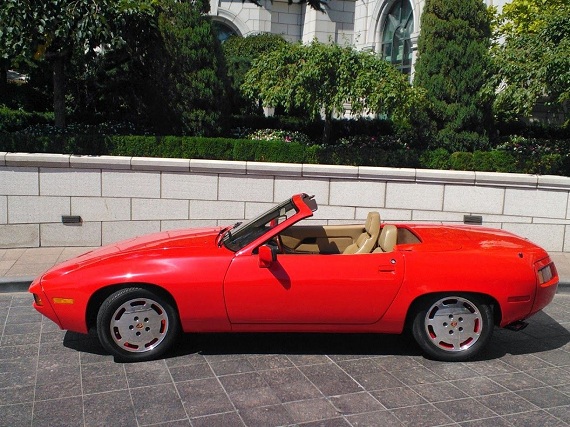
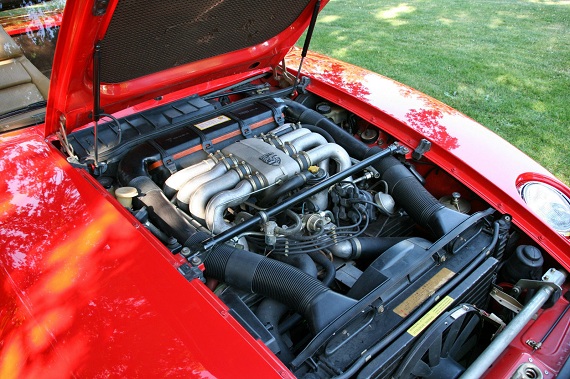
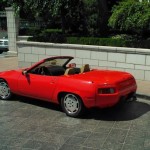

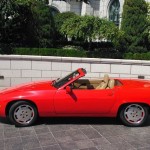
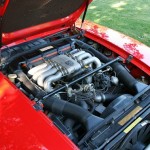

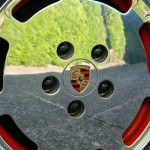
I read that Tom Selleck’s character in Magnum PI was originally going to drive a convertible 928, but that a deal with Porsche couldn’t be struck. The Ferrari 308 worked out just fine in its place. But I can’t help but think how different things would be today if the Porsche took the role. There would be a lot less 308s floating around and a lot more 928 cabs.
Carter, it’s because the yuppie dream was to drive a nice car with the top down in LA.
JP; interesting story, and you’re right if that had been the eventuality! sam; maybe? But there were already nice convertible cars you could have – including Porsches – so it was clearly not just that, but a desire to have what others didn’t in a very strange way? I guess in retrospect, there are many more convertibles available now that weren’t then, but I still don’t look at the Audi A7, BMWi8, or Porsche GT3 and think “You know what’s missing?”
Well, the 911SC Cabriolet and the Mondial convertible didn’t arrive until 1983 so the choice for flashy convertibles wasn’t all that great in 1981. There were Aston Martins, Mercedes Benzes and that’s about it. T-tops and Targas were the only other options at the time.
I like it….
it looks great w/the soft top down….I’d lose the wood steering wheel…and the auto is a turn off for me..
but the lines of the car are still there….
I’m more curious as to the driving characteristics of the car…chopping off the roof on that design must have given the car a whole new dynamic…..not that the owner would have driven it like Tom Cruise in Risky Business…LOL
while the mileage is really low…the leather interior looks to show more than that
According to this article, the MPI producers wanted a 928 with an extra large sunroof, not a convertible. But apparently, Porsche wouldn’t do a special order and so MPI went with the 308. Which is strange as by 1981, Porsche was offering their Sonderwunschprogramm program which knew almost no limits to what Porsche would do for a customer. http://magnum-mania.com/Articles/The_Ferrari.html